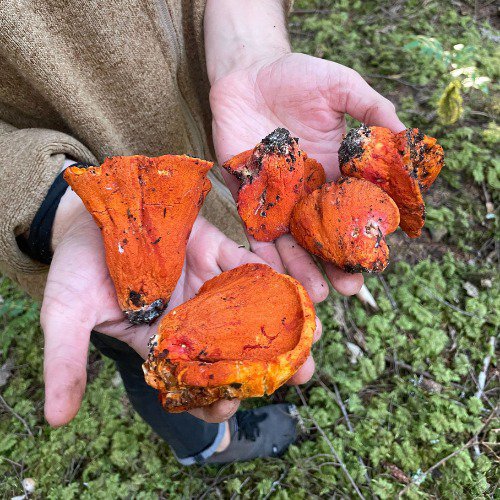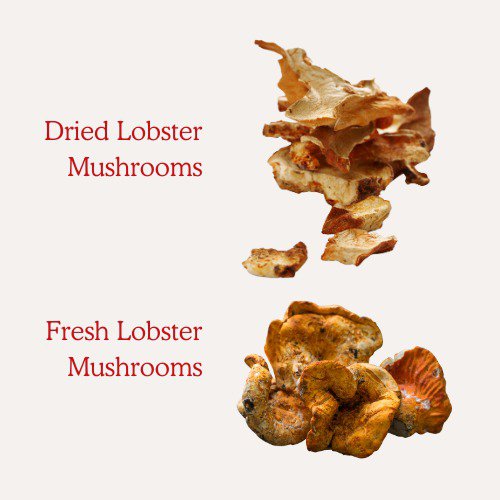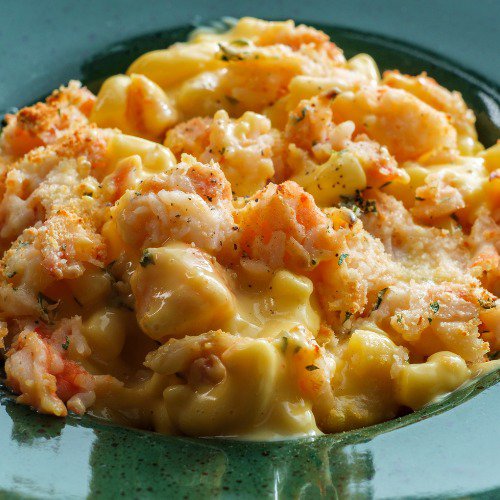Menu


Lobster mushrooms are a fall favorite amongst foragers. These delicious fungi make a great addition to many dishes, like pasta, soups and stews, and even sandwiches. Below we present you with what we consider to be the ultimate lobster mushroom recipe to add to your culinary repertoire.
Incidentally, lobster mushrooms are not actually mushrooms – more on that below – but they are absolutely delicious and have health benefits worth noting!
We’ve also included two additional flavorful recipes that are sure to become favorites in your home kitchen as economical and meat-free alternatives to seafood dishes. So let’s dive in and explore the world of lobster mushrooms and discover why you should consider eating lobster mushrooms regularly.
There are three main ways to acquire lobster mushrooms.
The first option is to visit local organic produce markets. You would be able to find lobster mushrooms during later summer and the fall when these delightful wild mushrooms are in season. However, they are usually only available fresh in the Northern parts of the USA and Southern parts of Canada, where they grow in the wild.
If fresh lobster mushrooms are not an option in your area, you can find many online sellers of dried mushrooms that may have them available. Take care to vet the quality of their company and products to avoid getting old, stale, or low-quality dried mushrooms.
Alternatively, if you're feeling adventurous, you can forage for lobster mushrooms yourself using these tips.
Lobster mushrooms have no toxic lookalikes, so they are generally easy to identify without risk.

A lobster mushroom is not technically a mushroom at all! It is a growth that forms when a certain parasitic fungus consumes one of two types of common mushrooms: Short-stalked Russula (Russula brevipes) or Lactarius mushrooms.
As the fungus eats up the host mushroom, it generates a strangely delicious orange-red output that looks and tastes suspiciously like a cooked lobster tail. So, if you want to be technical about it, you’d be cooking up Hypomyces lactifluorum.
To the mushroom aficionado, this happy fungi accident may sound familiar: See how chaga forms.
Lobster mushrooms have a unique flavor profile that sets them apart from other varieties. They offer a savory taste reminiscent of seafood. Their texture is firm yet tender, and they get slightly sweet as they cook. Similar to culinary uses of lion’s mane mushrooms, they are a popular substitute for seafood in dishes.
A great lobster mushroom recipe will ideally make use of the similarities between this fungus and real lobster meat, making it a delightful experience to eat lobster mushrooms.
Aside from their delectable taste, lobster mushrooms also provide some health benefits. They are packed with essential nutrients such as vitamins B and D, potassium, and iron. Like other culinary mushrooms, these are low in calories but dense in fiber, so they are ideal for filling you up and supporting your gut health.
If you are using fresh lobster mushrooms, preparation prior to cooking is simple. Rinse them under cold water to remove any debris, then move on to the next step below.

Before incorporating fresh lobster mushrooms into a recipe, it's crucial to prepare them properly. Start by cleaning the mushrooms thoroughly using a soft brush or damp cloth to remove any dirt or debris. Then slice them according to your desired thickness.
For each of the recipes below, we recommend sautéing the lobster mushrooms in a preheated pan with olive oil or butter until they turn golden brown. Make sure the pan is already hot prior to putting the mushrooms in. This is key to cooking mushrooms so they don’t go soggy.
The CEO of Real Mushrooms, Skye Chilton, created the video below of his lobster mushroom foraging and how he cooked up these delicious delicacies:
Now that we’ve covered the basics of lobster mushrooms, let’s dive into the recipes!
The following recipe can be made using fresh or dried lobster mushrooms. We have included preparation instructions for the mushrooms themselves just above this section.
This delightful creamy pasta dish featuring flavorful Hypomyces lactifluorum is a perfect choice for adventuring into a new and delicious culinary realm. It’s especially fun to experiment with ingredients like these if you’re looking for satisfying meat or seafood substitutes.

Our Chief Medical Herbalist, Lee Carroll, created this wholesome, creamy "lobster" bisque recipe. Freshly foraged lobster mushrooms were used here, but you could easily swap with rehydrated dried ones if that’s all you have on hand.

Ingredient List:
Total Cook Time: 45 minutes

Tip: Serve with a side of brussel-sprouts tossed in a mixture of olive oil and butter for taste.
We found this drool-worthy recipe for meat-free lobster rolls and couldn’t resist including it! If you’re craving a satisfying sandwich, this is one recipe you will definitely want to try. The original recipe can be found on Forager Chef, or view his YouTube video below.
When it comes to the lobster mushroom, it is one of those strange treats that nature, in all her weirdness, has created, and our tastebuds happily benefit from.
If you make any of these tasty dishes, be sure to share some photos and tag us on Instagram or Facebook!

Disclaimer: The information or products mentioned in this article are provided as information resources only, and are not to be used or relied on to diagnose, treat, cure, or prevent any disease. This information does not create any patient-doctor relationship, and should not be used as a substitute for professional diagnosis and treatment. The information is intended for health care professionals only. The statements made in this article have not been evaluated by the Food and Drug Administration. Any products mentioned are not intended to diagnose, treat, cure, or prevent any disease. The information in this article is intended for educational purposes. The information is not intended to replace medical advice offered by licensed medical physicians. Please consult your doctor or health practitioner for any medical advice.
